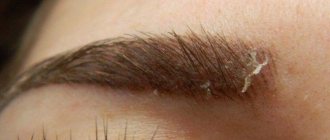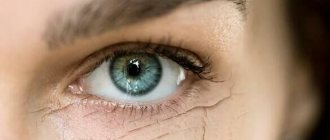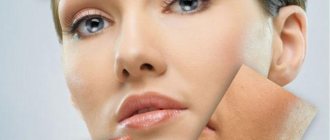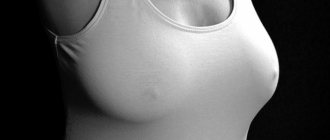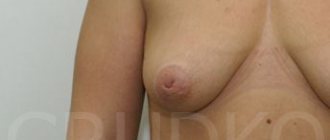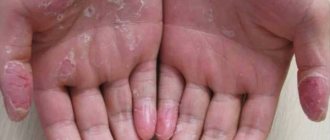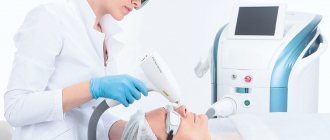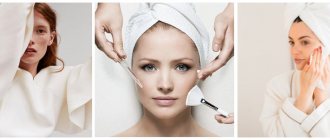Sometimes a woman may begin to be bothered by unbearable itching in the area of the nipples and areolas of the mammary glands. Most often, there is no reason to worry - itchy sensations can be caused by wearing synthetic underwear or be an allergic reaction to poor nutrition.
But if itching and burning in the nipple area are accompanied by other alarming signs, such as discharge from the mammary gland and pain, contact a mammologist immediately. Perhaps some kind of infection or pathology has begun to develop in the body.
Let's find out all the answer options to the question, why do nipples itch?
Dry skin on the nipples. Why do my nipples peel?
Peeling nipples are one of the problems that women often face.
This can be due to many reasons and occurs regardless of the woman’s age and condition. In any case, if nipple peeling or itching occurs, you should consult a doctor to find out exactly why your nipples are peeling. You can tell your gynecologist or mammologist about this problem. Peeling nipples are not always associated with a serious illness. It often goes away on its own and does not require special treatment. However, if peeling begins to seriously bother you and is also accompanied by itching, then it would be a good idea to consult a specialist.
Why do women's nipples peel?
Let's look at why the nipple skin peels. There may be several reasons for this:
- Pregnancy. During pregnancy, the whole body is rebuilt, the breasts at a certain period begin to fill with milk, the skin stretches, and therefore peeling and often itching occurs. However, if your chest itches constantly and this causes serious discomfort, you should definitely consult a doctor.
- Urticaria. At the same time, the skin becomes mottled and itchy.
- Dermatitis (usually contact). Perhaps the fabric from which the underwear is made causes allergies.
- Chemical irritation. Such irritation will manifest itself not only as peeling, but also itching, rashes, swelling, and a burning sensation. A crust may even appear on the surface of the breast.
- Allergy. Such an allergic reaction can occur, for example, to certain chemicals. Often a similar reaction can be observed to body care products (creams, shampoos, soaps, balms, etc.). This may result in an allergy to the washing powder used to wash clothes.
- Eczema. This is a serious dermatological disease that requires mandatory treatment by a skin specialist.
- Lack of moisture in the body. When there is a lack of fluid, the first sign is dry skin. In this case, the mucous membranes and skin around the nipples dry out first, which causes peeling.
- Hormonal changes. Peeling on the nipples most often occurs in the second half of the menstrual cycle, that is, when menstruation approaches. Sometimes peeling occurs during ovulation (that is, in the middle of the cycle), when the breasts swell, the skin stretches and peeling appears.
- Lack of vitamins. Hypovitaminosis is one of the common causes of peeling of the skin, and on the chest in particular.
- Breast diseases (especially if there is atypical discharge from the nipples).
- Breast growth in girls during adolescence.
Treatment of peeling nipples and preventive measures
The presence of an infectious disease, the consequence of which is peeling of the skin on the chest, you must follow the recommendations:
- Restoring normal water balance and maintaining it.
- Increasing the amount of vitamins in the diet.
- Breast care and hygiene during breastfeeding and pregnancy.
- Immune support.
- Beware of substances that may cause allergies.
If you cannot independently determine the cause of peeling nipples, and cracks, itching and pain persist, consult a doctor. Sometimes these symptoms can be signs of a serious illness, including cancer.
Only by establishing an accurate diagnosis can you cope with peeling in the nipple area:
- The body's reaction to pregnancy is treated with an anti-inflammatory cream. and healing effects, olive oil with vitamin E.
- An allergic reaction requires identification of the allergen. To do this, you need to get tested and use antihistamines.
- If you have allergic dermatitis, avoid synthetic underwear and household chemicals with additives.
A dermatologist who treats eczema can help you with this. Selects a treatment regimen and effective drugs, taking into account the individual characteristics of the patient.
If the water balance is disturbed, a woman is recommended to have 2 liters of water in her diet, an infusion of rosehip or chamomile, and fruit and vegetable juices without sugar. Coffee, alcoholic and carbonated drinks should be excluded.
If a vitamin deficiency is diagnosed, a diet and vitamin complex are prescribed that can solve the problem. To exclude the occurrence of dangerous diseases, women over 40 years of age should undergo regular preventive examinations with a mammologist.
Itching on the nipple halo. Peeling on the nipples: causes, possible diseases, treatment
The epidermis of the breast reacts sharply to any irritants, so many women suffer from flaking skin on their nipples. Most often, a defect appears for completely harmless reasons and causes inconvenience only from an aesthetic point of view. But sometimes the problem is a signal of a serious pathology.
Main causes of dry breast skin
You need to understand that along with allergies, not only peeling appears near the nipples, but also red spots all over the body, which almost always itch.
First of all, you need to keep in mind the following possible reasons:
- Pregnancy and lactation. In the later stages of pregnancy, a woman secretes colostrum from her nipples in small portions. It dries quickly, leaving a feeling of tightness. During feeding, the baby actively sucks at the breasts, damaging thin skin and leaving microtraumas.
- Allergy. Sources of allergens usually include cosmetics and detergents, chlorinated water, washing powder, and synthetic fabrics. A reaction to food is also possible. In response to irritation, the skin becomes scaly and itchy.
- Water imbalance. When there is a lack of fluid in the body, the most sensitive areas of the epithelium begin to dry out first. In this case, you need to drink plenty of water and avoid diuretics.
- Avitaminosis. Lack of vitamins and microelements has a detrimental effect on appearance. Nails and hair suffer along with the skin. If the problem is hypovitaminosis, the woman experiences decreased performance and chronic fatigue.
- Breast growth. Girls often notice peeling nipples before menstruation. The fact is that during this period the production of progesterone increases. The hormone causes the mammary glands to swell, causing the skin to stretch and become damaged. A similar process occurs during puberty, when taking hormonal contraceptives, and also during pregnancy.
- Unbalanced diet. An excess of sweet, spicy, smoked, and alcoholic foods leads to the accumulation of a large number of irritants in the blood. Nipples and areolas react to toxins by becoming dry and tight.
The most common causes include pregnancy, lactation and hormonal changes.
Peeling nipples as a sign of disease
Sometimes dry breast skin indicates the development of a disease. These can be dermatological diseases and pathologies of internal organs, including oncology:
- Eczema. A dermatological disease characterized by the appearance of scaly foci of inflammation. Patients are bothered by severe itching and burning. Similar symptoms occur in people suffering from psoriasis and dermatitis.
- Diabetes. Disruption of the endocrine system, consisting in problems with the absorption of glucose. The disease is accompanied by severe dry skin, hunger and thirst that cannot be suppressed, sudden weight loss, and profuse purulent rashes.
- Thrush. Many are accustomed to thinking that this disease affects only the genitals, but this is not so. Fungi can multiply on any mucous membrane if favorable conditions are created for them. Nursing mothers often suffer from candidiasis. Pathogenic microorganisms enter the breast from the baby's mouth, causing flaking of the skin on the nipples, itching, rash and severe pain during feeding.
- Mastitis. Inflammation of the mammary gland. Usually affects nursing women. With the disease, breast swelling, the appearance of compactions, and an increase in local temperature are observed. Redness and dryness appear, and pus is released with milk.
- Inflammatory cancer. The symptoms resemble mastitis. The tissues become deformed and resemble lemon peel in appearance. The nipple retracts and a feeling of heaviness appears in the chest. Local lymph nodes become inflamed, and general signs of intoxication are observed.
- Armor cancer. It is characterized by a reduction in the mammary gland and its upward displacement. Redness affects the entire chest, armpit and arm. The chest tightens, breathing becomes difficult. Erosion and cracks appear around the nipple.
- Paget's disease. A form of oncology affecting the nipple. The first symptoms include redness and irritation. There is peeling of the nipple areola. The nipple itself becomes flat and tight. Numerous ulcers and erosions form. Local lymph nodes become enlarged and serous or bloody discharge appears.
- Ductectasia. Pathological enlargement of the milk ducts. The condition itself is not dangerous, but it can be a sign of a serious illness. Manifests itself in the form of compactions in the peripapillary area, itching, burning, and swelling. The nipple moves to the side and secretes an unknown fluid.
- Melanoma. It looks like a birthmark. You can understand that this is not just pigmentation by peeling, a sharp increase in size and bleeding.
The skin on the nipple and areola can peel off for a variety of reasons. If nothing else bothers you other than the appearance of scales, then you don’t have to worry. The appearance of pain, discharge and rash is an alarming signal. In this case, you should not delay visiting a dermatologist or mammologist.
Change in color of the nipple areola. Features of changes in nipple color after conception
Why do nipples darken in pregnant women?
Darkening of the nipple skin is one of the first signs of pregnancy. With conception, the nipples not only become darker in color, they become much rougher, and their sensitivity increases to such an extent that even a light touch causes painful discomfort. Brown or dark pigmentation can be either uniform or appear in different areas of the breast.
Why does this happen, what causes darkening of the nipples in expectant mothers? It is necessary to highlight the main processes occurring in the female body after conceiving a child:
| Causes of nipple discoloration | Peculiarities |
| Active hormonal changes | The production of the hormone melanin, which is responsible for the color of human eyes, hair and skin, increases. With the onset of pregnancy, an increased accumulation of this substance is noted precisely in the tissues of the nipples, thereby causing its significant darkening. |
| Deficiency of certain beneficial vitamins and microelements | A lack of folic acid or vitamins B and D can lead to severe dark pigmentation of the nipples and areola. |
| Genetic predisposition | Nipples can also darken if this phenomenon has been observed in pregnant women in the female line. |
According to experts, excessive pigmentation during gestation is the result of a simultaneous combination of all these factors.
There is a hypothesis that for babies who still have poor vision after birth, it is much easier to distinguish dark nipples against the background of the white skin of the mammary glands. Regarding the areolas, they do not always turn brown - mostly pigmentation appears only on the nipples.
The intensity of darkening of the nipples of the mammary glands depends on how susceptible the woman is to hormonal fluctuations:
- In some pregnant women, the change in the shade of the nipple skin is slight, while in others the color may become dark brown or almost black, especially in dark-haired pregnant women.
- In women with fair skin type, pigmentation appears in a red tint, which is also considered normal.
The sudden appearance of a brown tint on the areola and nipples in the first trimester, as well as on the white line of the abdomen or on the face, which disappears over time, is also not a deviation.
It is also not a pathology when, after the baby is born, the pigmentation does not go away or it fades a little without returning to its original shade.
During what period of pregnancy does darkening of the nipples occur?
Dark pigmentation of the nipples begins to appear early, around the fourth to sixth week of pregnancy. The usual pink skin tone gradually turns brown. However, in other pregnant women, the manifestation of pigmentation occurs unnoticed and becomes more pronounced at 36-37 weeks, and in others there are no changes at all in either the nipples or glands.
As mentioned earlier, the color change is explained by the increased level of melanin in the body, which is produced by the fetus in huge quantities. Sex hormones also contribute to the active production of this substance.
Dark nipples during lactation
Dark-colored areolas and nipples in breastfeeding women indicate hormonal surges.
However, the manifestation of brown pigmentation can also occur if the baby is not applied to the breast correctly - the baby squeezes the gums tightly, which subsequently leads to injury and darkening of the nipples, and then they begin to hurt and crack.
When will the natural color of the nipples return?
The previous color of the nipples will return after pregnancy or with the end of breastfeeding, so there is no reason to worry if there are no clinical symptoms that would suggest the presence of some kind of disease.
Often in the third trimester, the nipple skin lightens a little, and sometimes becomes milky white just before birth.
Peeling and itching on the nipple. Why do my nipples peel?
Peeling nipples are one of the problems that women often face. This can be due to many reasons and occurs regardless of the woman’s age and condition. In any case, if nipple peeling or itching occurs, you should consult a doctor to find out exactly why your nipples are peeling. You can tell your gynecologist or mammologist about this problem.
Peeling nipples are not always associated with a serious illness. It often goes away on its own and does not require special treatment. However, if peeling begins to seriously bother you and is also accompanied by itching, then it would be a good idea to consult a specialist.
Why do women's nipples peel?
Let's look at why the nipple skin peels. There may be several reasons for this:
- Pregnancy. During pregnancy, the whole body is rebuilt, the breasts at a certain period begin to fill with milk, the skin stretches, and therefore peeling and often itching occurs. However, if your chest itches constantly and this causes serious discomfort, you should definitely consult a doctor.
- Urticaria. At the same time, the skin becomes mottled and itchy.
- Dermatitis (usually contact). Perhaps the fabric from which the underwear is made causes allergies.
- Chemical irritation. Such irritation will manifest itself not only as peeling, but also itching, rashes, swelling, and a burning sensation. A crust may even appear on the surface of the breast.
- Allergy. Such an allergic reaction can occur, for example, to certain chemicals. Often a similar reaction can be observed to body care products (creams, shampoos, soaps, balms, etc.). This may result in an allergy to the washing powder used to wash clothes.
- Eczema. This is a serious dermatological disease that requires mandatory treatment by a skin specialist.
- Lack of moisture in the body. When there is a lack of fluid, the first sign is dry skin. In this case, the mucous membranes and skin around the nipples dry out first, which causes peeling.
- Hormonal changes. Peeling on the nipples most often occurs in the second half of the menstrual cycle, that is, when menstruation approaches. Sometimes peeling occurs during ovulation (that is, in the middle of the cycle), when the breasts swell, the skin stretches and peeling appears.
- Lack of vitamins. Hypovitaminosis is one of the common causes of peeling of the skin, and on the chest in particular.
- Breast diseases (especially if there is atypical discharge from the nipples).
- Breast growth in girls during adolescence.
What can cause itching in the nipples of the mammary glands?
Why can nipples itch? The root cause usually lies in the wrong choice of underwear. Women are regularly explained that wearing synthetic and tight underwear is harmful to the body and all the same - for the sake of beauty, the fair sex is ready to sacrifice their health.
But tight and synthetic underwear can cause atopic dermatitis, eczema and other skin irritations.
Also pay attention to the cosmetics you use - perhaps your nipples are itchy because you are allergic to one of the components of the cosmetic product. Itchy nipples are one of the signs of eczema.
Eczema appears for various reasons, but its symptomatic range is very similar to nipple oncology, so do not self-diagnose, but seek advice from a specialized specialist.
Dead skin on the nipples. Main reasons
Factors that provoke irritation of the skin under the mammary gland and around the areolas are conventionally divided into external and internal. External reasons include:
- tight or too loose underwear that injures the dermis;
- bras and T-shirts made of synthetic fabrics;
- incorrectly selected cosmetics;
- washing powders and gels containing toxic additives and strong allergens;
- influence of ultraviolet radiation, sea or hard tap water;
- chemical and mechanical peelings.
Internal causes of nipple irritation are also divided into subcategories: hormonal, dermatological, physiological, neurological and somatic, which are associated with the patient’s lifestyle.
Hormonal factors include:
- hypothyroidism – leads to loss of skin elasticity, dryness and itching;
- diabetes mellitus – causes dehydration, peeling, cracking and redness;
- mastopathy - occurs against the background of an increase or decrease in estrogen levels, accompanied by soreness of the mammary glands, redness, itching and peeling around the nipples.
Paget's cancer is a separate category - a malignant tumor that can occur against the background of hormonal disorders and intoxication of the body. The pathology at the initial stage is accompanied by mild peeling and irritation of the skin of the nipples or areolas, and increased sensitivity. Then, pain, burning, discharge from the mammary glands and weeping eczema, which periodically become crusted, are added to the primary symptoms.
The most common dermatological causes are:
- eczema - dryness, itching and burning are often accompanied by cracks, ulcers and small blistering rashes filled with purulent contents;
- atopic dermatitis – causes redness and swelling of the area around the nipple, as well as the appearance of light pink or brown spots on the mammary glands (MG);
- fungal infections - lead to the appearance of pink or red spots with a clear outline, cause severe itching and flaking, in some cases - inflammation of the milk ducts and discharge from the nipples;
- thrush - refers to yeast fungi, has similar symptoms to other fungal diseases, but it is also characterized by a white coating.
Physiological causes include pregnancy and lactation. Especially often the skin of the nipples dries out in women whose concentration of micro- and macroelements decreases during pregnancy, and whose mammary glands grow too quickly.
Prolactin and estrogens are the main reason why nipples and breast skin dry out during pregnancy. It is these hormones that stimulate rapid growth of the breast and stretching of the dermis. It is impossible to influence the concentration of prolactin while carrying a child, but you can reduce the consequences of hormonal changes in the body with proper nutrition and breast care.
During lactation, burning and cracking appear due to improper feeding. The baby should grasp the entire pigmented areola. If it takes only part, it leads to stretching of the skin and microtrauma.
Neurological causes of peeling include severe and chronic stress, sleep problems, increased anxiety and depressive disorders. Other somatic factors also include dehydration, lack of nutrients due to diets or unbalanced nutrition, taking certain medications, poor hygiene and decreased immunity.
Warning symptoms
Not all causes of peeling can be eliminated on your own without first consulting a doctor. For example, thrush, eczema, psoriasis require qualified assistance, individual choice of medications, and selection of daily dosage.
You can suspect a fungal infection and candidiasis based on the following symptoms:
- the presence of non-specific discharge from the nipples, which has a green, brown, white color and a strange smell;
- elevated temperature;
- rash on the skin of the glands, in the armpits;
- darkening of the epidermis around the areola, on the chest itself;
- sour odor from the armpits and submammary region.
The following clinical manifestations indicate eczema and psoriasis:
- the presence of ulcerative formations, weeping crusts on the surface;
- large silvery or bright red spots with clear contours;
- discharge of liquid exudate from the nipples and the peripapillary area.
The following symptoms should be a reason to consult a doctor:
- formation of a lump in the mammary gland or nipple of any size;
- asymmetry of the mammary glands;
- “recession” of the nipple deep into the chest;
- hyperemia;
- pain syndrome.
Discomfort and pain in the mammary glands, occurring in combination with peeling of the nipples and not associated with menstruation, often indicate the presence of a benign or malignant tumor.
Monitoring the health of the mammary glands is necessary during lactation, since constant milk production creates a favorable environment for the penetration and activity of bacteria.
Peeling nipples in adolescents. Physiological changes during pregnancy
Nipples peel during pregnancy with the appearance of characteristic cracks and pain on the skin due to a violation of the integrity of the skin. Dryness and peeling of the nipples when carrying a child can occur due to:
- reduced levels of vitamin A and vitamin B complex in the body;
- imbalances and hormonal changes;
- inflammation and irritation of the skin (this occurs due to the fact that a special juice, colostrum, is secreted from the nipple from time to time).
In most cases, such peeling on the chest occurs in a pregnant woman only in the third trimester. And although peeling is not a sign of the development of the disease, you need to consult your doctor and undergo a set of diagnostic procedures to prevent the appearance of cracks, which, in addition to pain, will also negatively affect the normal feeding of the newborn.
To get rid of cracks and dry skin, you need to lubricate your nipples with a special cream for stretch marks, which is used by almost all young mothers. It can also be used during feeding, but before giving the breast to the baby, you need to rinse it thoroughly. Additional symptoms of peeling:
- nipple color changes;
- general body temperature rises;
- characteristic swelling;
- symptoms of inflammation and redness of the skin;
- one-sided disease;
- the presence of additional secretions (in addition to colostrum);
- in some cases, in addition to peeling, there is increased sensitivity of the nipple.
Any of these symptoms is a serious reason to consult a gynecologist.
Why do nipples hurt and itch in men?
Both men and women can experience breast pain and discomfort in the nipple area. They are often the first sign of serious pathology. Peeling occurs in diseases:
- Gynecomastia. With this disease, breast enlargement occurs. The cause of the disease lies in hormonal disorders, heredity, long-term use of anabolic steroids and some other drugs, diseases of the thyroid gland or liver.
- Paget's disease. Another name for this disease is breast cancer. After 60 years, it affects the male body in the same way as it does the female. It is characterized by compactions in the nipple area. It develops slowly, so the prognosis for treatment is favorable. Predisposition to this type of cancer increases with the presence of factors: heredity, radiation, bad habits, use of preservatives and harmful chemicals.
- Mondor's disease. Superficial thrombophlebitis located on the side of the chest. Difficult to diagnose due to similarities to breast cancer. Often occurs for no apparent reason. This can occur as a result of injury and damage to the skin. Symptoms of the disease: soreness, a clearly thick lump under the skin, tightening and wrinkling of the affected area. She is treated on an outpatient basis, the prognosis is favorable.
- Diseases of the testicles, pituitary gland and adrenal glands also cause hormonal imbalance. Symptoms of pathology: female infertility and obesity. Treatment consists of eliminating the underlying disease, after which the hormonal levels return to normal. Sometimes hormonal treatment is also used to completely eliminate the discomfort and anxiety caused by unpleasant sensations in the nipple area.
- Injuries and infections. Breast trauma always causes severe pain in the nipple area. This goes away with time. If the area of injury or disease is complicated by infection, purulent inflammation develops. In this case, antibacterial treatment is carried out. Antibiotics should be prescribed if a man complains of nipple pain, a feeling of heaviness, pressure and stretching of the chest, erectile dysfunction and infertility.
Treatment is recommended depending on the cause of the disease. Therapy can be surgical or conservative, but is primarily aimed at eliminating the underlying disease.
Early diagnosis of the cause of nipple pain makes it possible not to lose sight of the presence of a malignant tumor.
Nipples can peel off for physiological reasons or as a result of unfavorable environmental factors. Only timely intervention by specialists and strict adherence to recommendations can stop the development of the disease and irreversible consequences in the body.
Peeling nipples during pregnancy
In this case, the process is associated with a change in the physiological state of the pregnant woman. During pregnancy, a number of indicators change, which include both hormonal levels and the pH of the skin itself; nipples become darker. All this helps to exfoliate the keratinized epithelium on the nipples, since during pregnancy the skin becomes drier than usual.
Warning! This photo contains information not intended for viewing by persons under the age of 18!
How to get rid of peeling
If the skin on the nipples peels due to insufficient fluid volume in the body, correction of the drinking regime is required: you need to drink at least 2 liters of water per day. If an allergic reaction is present, elimination of the irritant is required (avoiding wearing specific clothing, using shower gel, etc.).
The diet must include foods containing vitamins A, B, C, E, and omega-3 acids. When it comes to detergents and laundry products, you should give preference to soft powders and rinses, preferably those with a hypoallergenic effect.
After physical exertion and work that involves increased sweating, you should immediately take a shower. For sleep, you need to choose clothes that are made of natural material and do not compress the mammary glands.
It is recommended to avoid scratching the skin and nipples. If you have an itchy syndrome, it is better to apply a cold compress or any product from the refrigerator, wrapped in a cloth. After a shower, the skin can be treated with baby powder or cream, which will eliminate redness and irritation.
Medicines
Peeling skin on the nipples can be eliminated with special preparations with a moisturizing effect. Such drugs are prescribed if there is no purulent discharge from the ducts, non-healing ulcers, and the epidermis is characterized by increased dryness and tightness.
The first and most popular product is La-Cri, released in the form of a cream. Among the components included are vegetable oil from wheat germ and jojoba. These combat epidermal dehydration and flaking. Due to the presence of beeswax in the cream, the activity of bacteria and viruses is suppressed.
Prescribed use of the product for hypovitaminosis, dehydration, hormonal imbalance, during pregnancy and breastfeeding. Apply to areas with peeling 2 times a day.
An excellent medicine is Bepanten, released in the form of a cream. It contains dexpanthenol and lanolin, which are safe for use during pregnancy and lactation. Substances help retain moisture in the epidermis, disinfect and stimulate regeneration. Apply the cream 2-4 times a day.
The drug Desitin in the form of an ointment contains zinc oxide, which has an antibacterial and drying effect. Due to the content of lanolin, cod liver extract, talc, and paraffin, the drug is effective in the treatment of weeping eczema, dermatitis, and diaper rash.
The ointment promotes tissue regeneration and has a preventive effect on the penetration and activity of pathogens in the ducts. The product is applied 3 times a day.
Peeling of the nipple areola can be removed with Videstim ointment. The main active ingredient is vitamin A. The drug is also developed on the basis of vaseline oil, glycerin, and wax.
It has a wound-healing, regenerating, moisturizing and toning effect. Used in the treatment of eczema, dermatitis, hormonal imbalance. The drug is applied 2 times a day.
The skin under the breasts is peeling
This issue needs to be considered separately, since in addition to the reasons described above, the process of peeling the skin under the breasts can cause increased secretion of fat from the sebaceous glands. This phenomenon can be caused by hormonal imbalances in the body, stress, a disorder of the immune system, as well as poor hygiene and diet. Poor nutrition can lead to excess oil secretion from the sebaceous glands. In this case, you need to optimize your daily diet and take more care of your personal hygiene.
If these measures are ineffective, it is imperative to seek qualified help from specialists.
Question to the expert
Please tell me why the skin under my breasts is red and peeling?
Peeling and redness of the skin under the breasts most often occurs due to increased secretion of fat from the sebaceous glands. A fold forms under the mammary gland, in which excess secreted fat is concentrated, as a result, the skin ducts become clogged, and inflammation occurs. You should also not lose sight of uncomfortable or new underwear, which can rub the skin under the breasts or cause allergic reactions in the form of irritation if the material of the new bra does not suit you. In this case, you need to stop wearing this bra. With increased secretion of fat from the sebaceous glands, it is necessary to monitor personal hygiene more often than usual to eliminate symptoms. But do not forget that this process can occur due to a violation of the diet, therefore, to eliminate peeling of the skin under the breasts, a set of measures is always necessary.
The spot on the chest itches and peels
The formation of spots on the chest may indicate skin diseases. A stain is a local process, so we cannot talk about any general changes that we talked about above. In this case, it is necessary to consider, first of all, diseases such as dermatitis, eczema, but in no case should we forget about oncology.
Question to the expert
Please tell me, after giving birth, red spots appeared on my chest and neck, they are constantly peeling.
Red spots after childbirth can appear due to two main reasons. The first is dry skin, which is caused by hormonal changes due to past childbirth, the second is dermatitis or eczema. Dryness can be combated with moisturizing creams, but even when using cosmetics you need to be careful, as they can penetrate deep into the tissue and affect the composition of breast milk. Therefore, it is necessary to consult a doctor before using such products. In case of dermatitis or eczema, consultation with a dermatologist is necessary. Also, one should not miss the moment of spots on the neck; they, as a rule, are characteristic of disorders of the vegetative-vascular system, which reacts to changes in the body associated with the past childbirth. It most often manifests itself in the form of dystonia, so consultation with a specialist in this case is mandatory.

